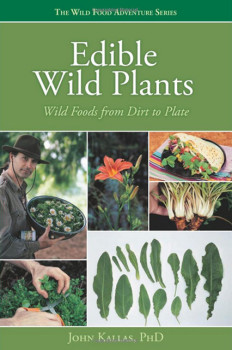 There’s a telltale photo of author John Kallas, Ph.D, in his 2010 book, Edible Wild Plants: Wild Foods from Dirt to Plate (Gibbs Smith). It’s a faded, 1973 shot of the then long-haired, bearded forager emerging from a swamp wielding cattail vegetables. John Kallas is the real deal. He’s been at the wild edible game a long time; he knows his plants well and has years of experience researching and eating them.
There’s a telltale photo of author John Kallas, Ph.D, in his 2010 book, Edible Wild Plants: Wild Foods from Dirt to Plate (Gibbs Smith). It’s a faded, 1973 shot of the then long-haired, bearded forager emerging from a swamp wielding cattail vegetables. John Kallas is the real deal. He’s been at the wild edible game a long time; he knows his plants well and has years of experience researching and eating them.
A visually appealing, glossy 400-page book with full-color photographs, Edible Wild Plants is the first in a planned multi-part Wild Food Adventure Series from Kallas, who founded the Portland, Oregon based Institute for the Study of Edible Wild Plants and Other Foragables and its educational branch, Wild Food Adventures (www.wildfoodadventures.com).
The author is a salad lover, judging by all the salad ideas in the book. He also enjoys putting wild edible greens on sandwiches and adding them to myriad other recipes. So it makes sense that Kallas’ first book should centers on greens—specifically, wild leafy greens that love disturbed soil zones.
For readers with farmland, gardens needing weeding or overgrown lots that they hope to forage, Kallas’ book is a superb resource.
In keeping with the current trend among wild edible authors to provide more detailed accounts of less plants (in contrast to traditional identification guides) Edible Wild Plants includes for each plant a detailed and thorough chapter featuring stories of the author’s experience, plant descriptions, photographs of growth stages, and food preparation ideas.
In total, Kallas’ first book features 15 weedy wild greens, their vegetables and seeds, in depth, but also includes edible family members and look-a-likes, with 40 different plants shown in one or more photographs in the book.
The book is organized into four parts. Part I is the wild edible plant intro—the what and the why and the how—including a fun and informative read on the many wild edible tool belt options available to us wild food foragers.
Part II is the meat of the book—and by “meat,” of course, I mean plants. Kallas takes an interesting approach to categorizing his wild greens into four culinary groups: foundation greens, which are “mild greens” that are “suitable for almost every occasion and will be accepted by almost anyone who doesn’t hate the sight of greens” with flavors that can “serve as the neutral base for salads containing stronger-tasting greens,” he writes; tart greens, including sorrels and docks; pungent greens, all of which are wild mustards; and bitter greens like dandelions, sow thistle and—you guessed it—nipplewort.
“Lookalike” plants are described on distinctive yellow pages where applicable.
Readers new to edible wild food will find enough information about a select group of common, easier-to-find, wild plants—ones that love disturbed areas and have a broad distribution across the US—to identify, sample, and begin using a number of different plants. More experienced foragers are bound to find out something they didn’t know before (I certainly had a couple of epiphanies, and I consider myself “mildly knowledgeable” on the subject)—and to get a few fun culinary ideas to boot.
I enjoyed his account and photographs of making “Mallowmallows”—his playful nickname for marshmallows made from the wheel-shaped fruits of common mallow (Malva neglecta)—as well as Huckleberry Mallow Merengue Pie, a riff on Euell Gibbons’ mayapple chiffon pie, though Gibbons did it with the root of the actual marsh mallow (Althaea officinalis) plant and Kallas accomplished it with M. neglecta.
I probably owe John Kallas some pennycress honey mustard, because this wild condiment, beloved in our household, is an adaptation of one of his wild hot mustard recipes.
Good Nutrition Info
In Part III of the book, “The Potential of Wild Foods,” Kallas argues for the value of learning, finding, gathering and eating wild foods—one point being the potential of wild plants to add healthy phytochemicals to the diet. A Ph.D in nutrition, he nonetheless writes, “I do not like microanalyzing the nutrients in my food. If you are not eating wild foods for the flavors, for the joy of it, or to reach some overall dietary lifestyle goal, you will not be doing it for long.” Therefore, while his nutritional charts and narrative accounts rank certain wild foods high in vitamin content, he finds the benefit of wild food consumption in the overall diversity it adds to the diet. He also points out that nutrient content can vary based on numerous factors.
In this section Kallas also debunks the sometimes-perpetrated myth of harmful oxalates and nitrates in wild foods by explaining that they are substances found in both wild and traditional greens that the adult human body processes on a regular basis in the context of a normal diet. (He does not recommend feeding pureed wild-foraged or traditional veggies, where the soil’s nitrate content is unknown, to infants).
Kallas concludes with tips on managing our wild gardens, and taking edible weeds off farmers’ hands.
Edible Wild Plants: Wild Foods from Dirt to Plate is not a comprehensive guide to all wild edible plants. It’s a detailed, reliable, fun, and visually appealing read that fills in the gaps for a set number of wild weedy ones, providing more details for these plants than traditional guidebooks can cover. It’s a great book to have in your wild edible library.
Purchase a signed copy of the book from Kallas directly at www.wildfoodadventures.com, or find print and Kindle versions on Amazon.

Leave a Reply